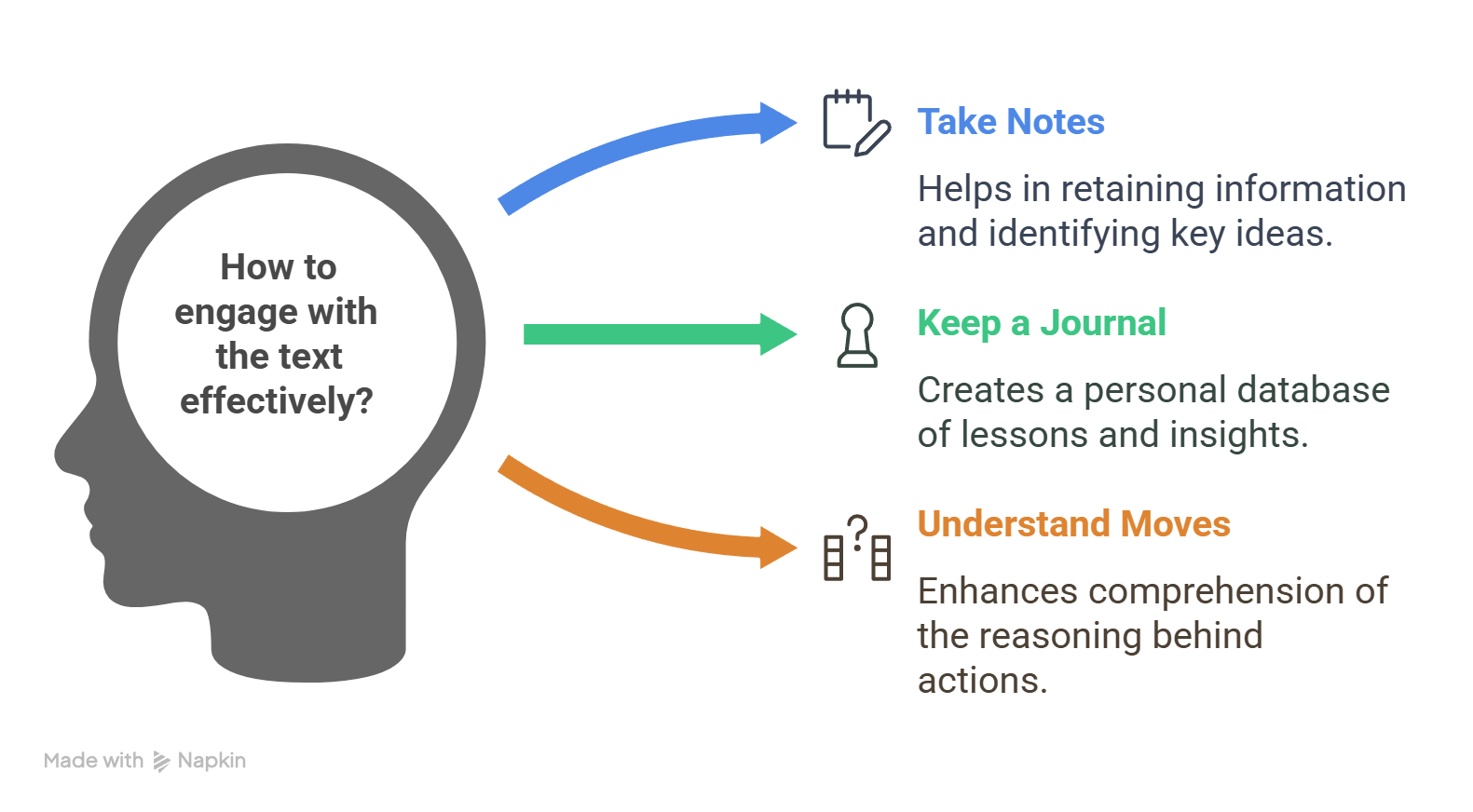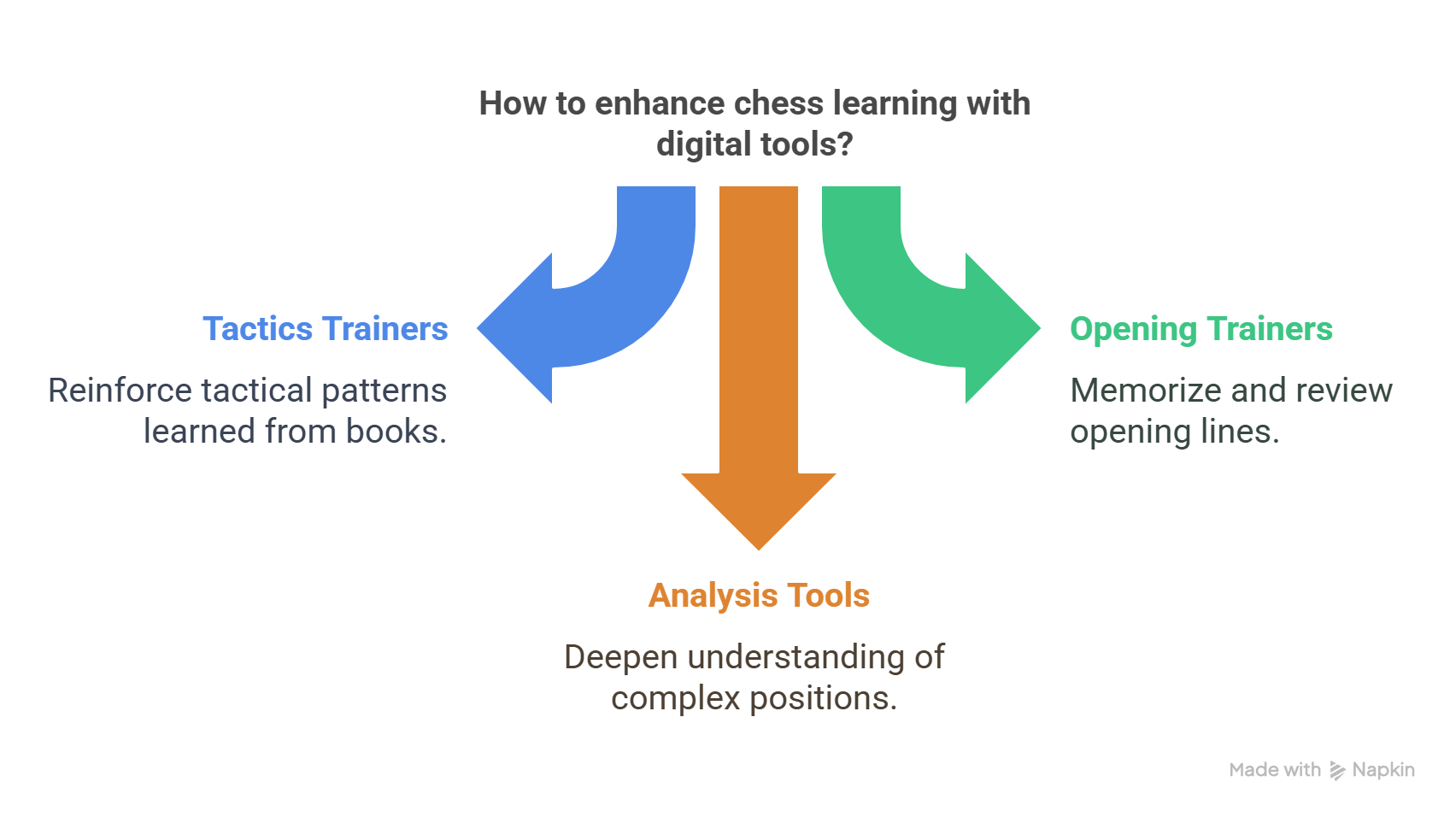Introduction
Studying chess books can be one of the most transformative ways to improve your game. If you’re wondering whether chess books are still useful in the digital age, I’ve explored that question in detail here. These timeless resources don’t just offer moves – they reveal the thought process behind them. They connect you to the minds of great players, help you understand strategic principles, and guide you through the depth of tactics and positional play. But how you study them makes all the difference .In this guide, we’ll explore how to study chess books in a way that leads to real improvement.
One of the most common mistakes players make is treating chess books like casual reading material. They flip through pages, nod at explanations, and hope the knowledge will sink in. Unfortunately, this passive approach rarely leads to meaningful improvement.
The goal of this blog is to change that. I’ll walk you through practical, actionable steps to help you get the most out of your chess books – so you can turn reading into real learning, and knowledge into stronger play on the board.
Choose the Right Book for Your Level
The first step to studying chess books effectively is choosing the right one. Picking a book that aligns with your current skill level is crucial – because a mismatch can either bore you or overwhelm you.
If the book is too simple, you’ll breeze through it without gaining much. If it’s too advanced, you’ll get frustrated, miss key ideas, and risk walking away feeling stuck or unmotivated. A well-matched book should challenge you just enough while remaining accessible.
Here are some solid book recommendations by level:
Beginner
- Chess: 5334 Problems, Combinations & Games by Laszlo Polgar
- Everyone’s First Chess Workbook by Peter Giannatos
- Chess Tactics for Kids by Murray Chandler
- 1001 Chess Exercises for Beginners by Franco Masetti
- Logical Chess: Move by Move by Irving Chernev
- Winning Chess Tactics by Yasser Seirawan
- Winning Chess Strategies by Yasser Seirawan
These focus on the rules, basic tactics, and simple strategy, with lots of diagrams and explanations written in plain language.
Intermediate
- Simple Chess by Michael Stean
- How to Reassess Your Chess by Jeremy Silman
- 1001 Chess Exercises for Club Players by Frank Erwich
- Silman’s Complete Endgame Course by Jeremy Silman
- Capablanca’s Best Chess Endings by Irving Chernev
These books explore why certain moves are played, helping you understand key decision-making principles, tactical patterns, and typical middlegame ideas.
Advanced
- Techniques of Positional Play by Valery Bronznik
- Art of Attack in Chess by Vladimir Vukovic
- My 60 Memorable Games by Bobby Fischer
- The Woodpecker Method by Axel Smith and Hans Tikkanen
- Endgame Strategy by Mikhail Shereshevsky
These are ideal if you’re already rated or have a solid foundation. They demand patience, but the insights they offer are incredibly deep and rewarding.
Tip: When in doubt, aim slightly below your level to reinforce core concepts. Mastery comes from repetition and clarity – not confusion.
Once you’ve found the right book for your level, the next step is understanding how to study chess books effectively so that each page deepens your understanding of the game.
Read Actively – Don’t Just Flip Pages
It’s tempting to breeze through a chess book the way you’d flip through a novel, but passive reading won’t do much for your chess. To truly benefit, you need to read actively – engaging with the content as if you’re having a conversation with the author. One of the core ideas behind how to study chess books is making your learning interactive.
Take notes. Annotate in the margins. Highlight key ideas.
Write down recurring themes, new patterns, or questions that arise as you read. Don’t be afraid to pause and think about a position before moving on. If something doesn’t make sense, mark it – chances are you’ll understand it better the second time around.
Keep a chess journal.
Use it to record “aha” moments, summarize chapters in your own words, and jot down how concepts apply to your own games. Over time, this journal becomes a personal database of lessons that you can revisit and build on.
Focus on understanding why a move is played, not just what was played.
Anyone can memorize a sequence – but knowing the reasoning behind each move is where true improvement happens. Ask yourself: What is this move threatening? What would happen if it wasn’t played? What principle does it reflect?
Reading a chess book should feel like solving a puzzle – not just watching the pieces move.

Quality Over Quantity – Go Deep, Not Fast
When studying chess books, depth matters more than speed. It’s not about how many books you finish—it’s about how well you understand the one you’re reading right now.
Rushing through a book might feel productive, but it usually leads to shallow learning. You might remember a few cool tactics, but the deeper lessons – the positional plans, the evaluations, the logic – will slip by unnoticed.
Instead, give yourself permission to slow down.
Try pacing yourself with 30 focused minutes per day.
During that time, aim to study one game or one small section thoroughly. Replay the moves on a board, pause at key moments, and reflect on the decision-making process. The more mental effort you put in, the more you retain.
Revisit chapters and repeat tough exercises.
Struggling with a concept? That’s a good sign – it means you’re learning something new. Go back to that section later and see if it clicks. Repetition cements understanding.
“One deeply understood game is worth more than a dozen games skimmed through.”
The goal isn’t just to finish the book. The goal is to absorb it.
Supplement Book Study with Digital Practice
Chess books provide depth, structure, and timeless wisdom – but pairing them with digital tools can supercharge your learning.
Use online platforms to apply what you’re learning in real time.
If you’re reading a book on endgames, practice those positions on a site like Chessable or Lichess. If you’re studying tactics, reinforce them through a tactics trainer like the one on Chess.com. This creates a feedback loop where theory meets practice.
Combine concepts with tools like:
- Tactics trainers (Chess.com, Lichess): Reinforce patterns you read about.
- Opening trainers (Chessable, Aimchess): Memorize and review lines from books.
- Analysis tools: Go deeper into positions that puzzled you.
Interactive learning provides instant feedback, which books can’t.
When you get something wrong online, you can immediately understand why. This speeds up the learning process and helps you spot your blind spots.
The best results come when you blend old-school study with modern tools.

Create a Simple Study Plan
Studying chess books is much more effective when you have a plan. Without structure, it’s easy to read a few pages and then forget about it.
Example Weekly Study Plan:
- Monday–Wednesday: 30 minutes reading + 15 minutes practicing concepts online
- Thursday: Solve 20–30 tactical puzzles
- Friday: Play 1–2 slow games online
- Saturday: Review your games and revisit book positions
- Sunday: Free day or optional study
Set clear goals for your study.
Do you want to improve your endgame technique? Learn a new opening? Get better at calculating tactics? Choose one or two focus areas per month and align your reading around that. Knowing how to study chess books also means knowing how to pace yourself. Set clear goals for your study.
Consistency beats intensity.
It’s better to study 30 minutes a day, five days a week, than to do a marathon session once a month. Chess improvement is a long-term process – it rewards habits, not heroic efforts.
A steady rhythm of reading, solving, and playing creates lasting progress.
Reflect and Review Regularly
Learning from a chess book doesn’t end when you close the cover. The real growth happens when you revisit, reflect, and reinforce.
Revisit your notes or key ideas after a few days or weeks.
This helps move concepts from short-term memory to long-term understanding. This habit is a cornerstone of how to study chess books – repetition and reflection help you turn theory into intuition. Whether it’s a brilliant maneuver or a common mistake, going back over your highlights solidifies the lesson.
Keep a simple progress log.
Record what you studied, what stood out, and how you applied it in games. Over time, this journal becomes a roadmap of your improvement – and a motivational boost when you look back at how far you’ve come.
Adjust your study based on what you’re struggling with.
Did a certain concept or chapter feel confusing? That’s a sign to slow down, re-read, or supplement with a video or coach’s input. Don’t power through – pause and dig deeper.
Reflection turns information into transformation.
Conclusion
Studying chess books the right way can elevate your understanding of the game in powerful ways – but only if you know how to study chess books with focus, structure, and curiosity.Studying chess books the right way can elevate your understanding of the game in powerful ways – but only if you approach it with focus, structure, and curiosity.
Here’s a quick recap of the key habits:
- Choose a book suited to your level
- Use a board (physical or digital) as you read
- Read actively – take notes and reflect
- Go slow and deep instead of rushing
- Reinforce lessons with online practice
- Build a weekly study plan around your goals
- Review regularly and adapt as you learn
Start small and be consistent.
You don’t need hours every day. Even 30 focused minutes a few times a week can make a big difference if you’re intentional about how you study.
Your next step:
Pick a book that excites you, set a realistic weekly schedule, and commit to learning actively.
Don’t just read chess books – study them, and let them sharpen every move you make.
FAQ
1. How long should I spend studying a chess book each day?
The ideal study time varies by individual, but 30 minutes a day is a great starting point. Consistency is key, so even short sessions add up over time. Focus on quality over quantity, and gradually increase your study time as you get more comfortable.
2. Can I study multiple books at once?
While it’s tempting to tackle several books, it’s better to focus on one at a time. Jumping between too many books can lead to confusion and shallow understanding. Master one book thoroughly before moving to the next.
3. How do I know if I’m ready for more advanced chess books?
If you’re struggling to understand the material or feeling frustrated, it might be a sign to stick with your current level. Advanced books assume a certain level of knowledge. Start with intermediate books, and once you’re comfortable with the concepts, you can challenge yourself with more complex texts.
4. Should I study books on strategy, tactics, or both?
Both are important, but the focus depends on your current needs. Beginners should prioritize tactics to sharpen pattern recognition, while intermediate players might want to study strategy to deepen their overall understanding. Once you’re comfortable with both, combine them for a holistic approach to chess improvement.
5. What should I do if I don’t understand a concept in my chess book?
Don’t get discouraged! Re-read the section, take notes, and try to apply the concept in games or exercises. If it’s still unclear, look for additional resources like videos or ask a coach for clarification. Sometimes, stepping away and revisiting the material later can help make the idea click.
